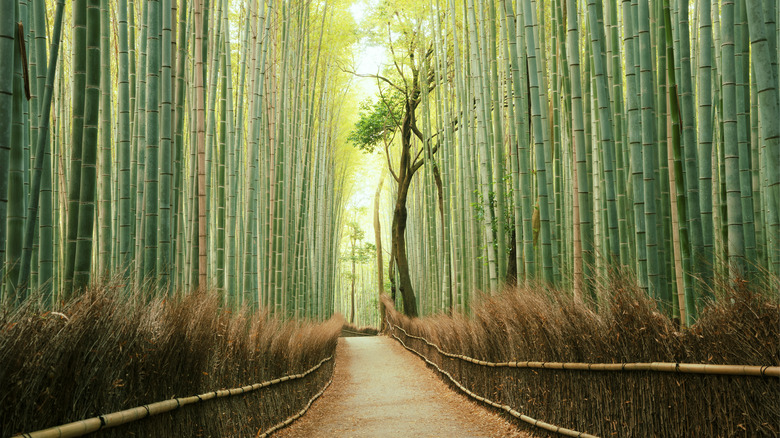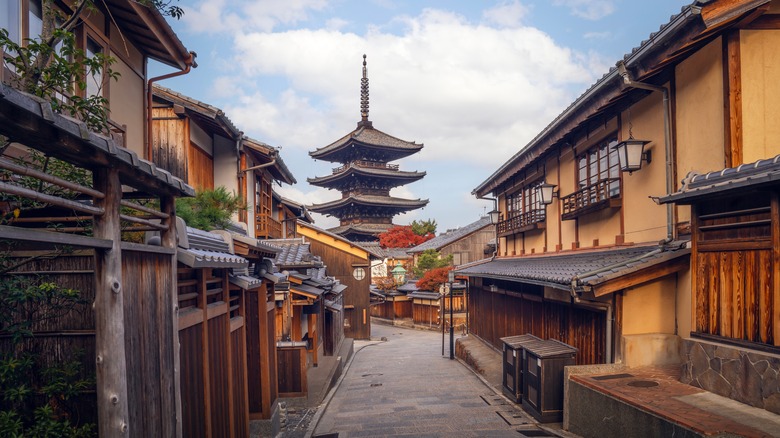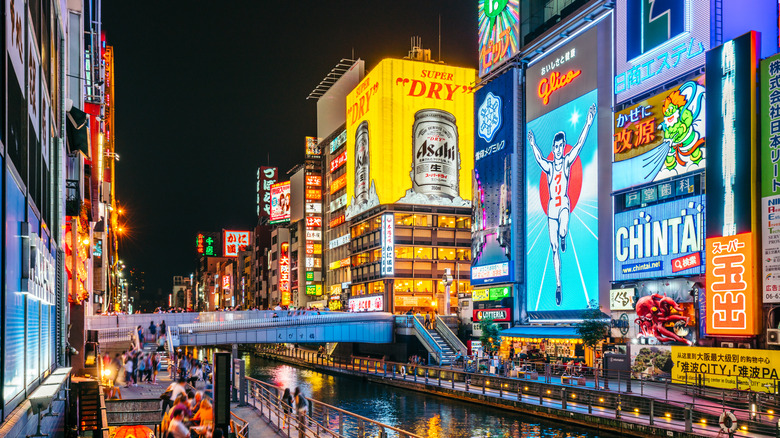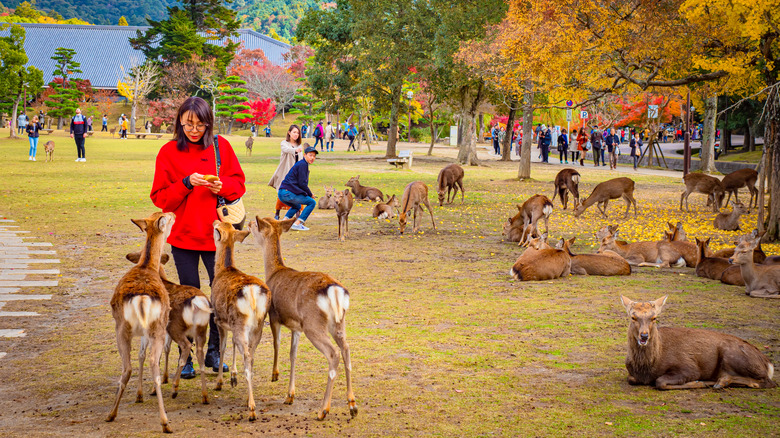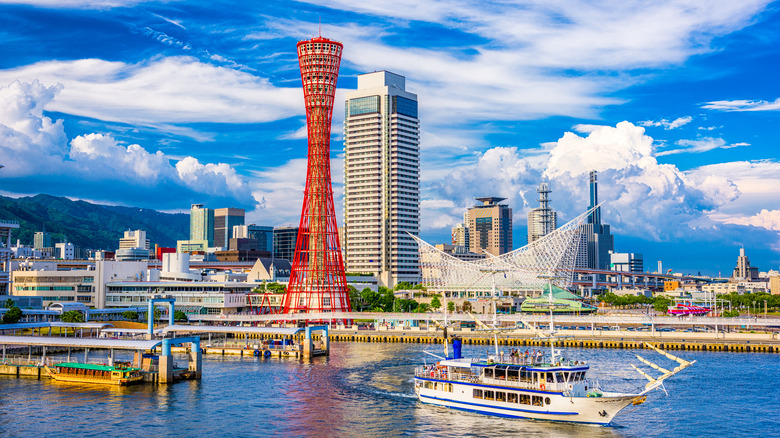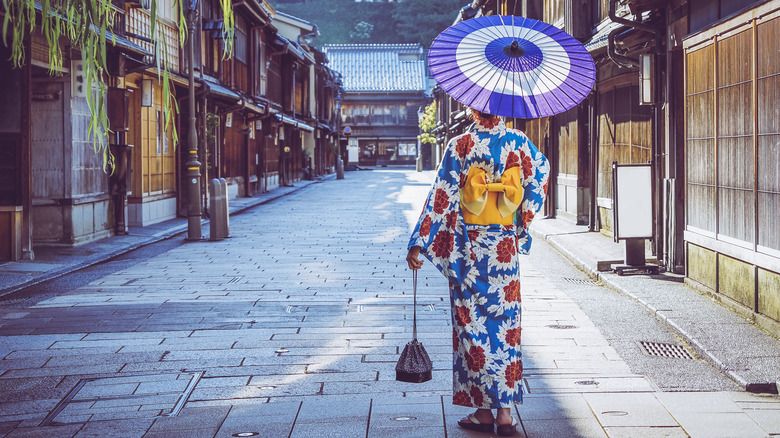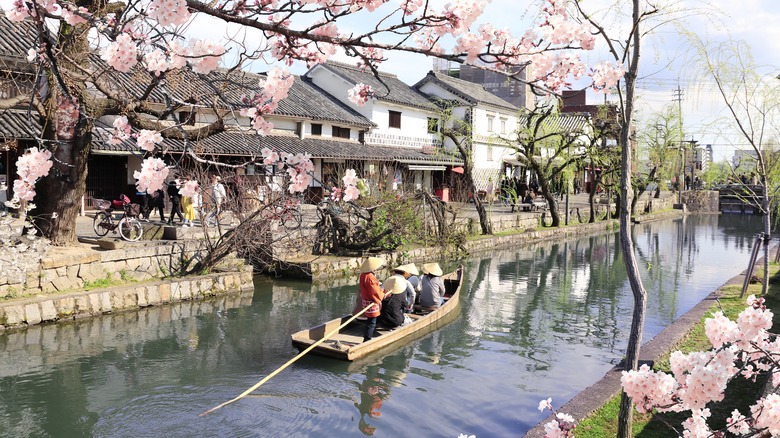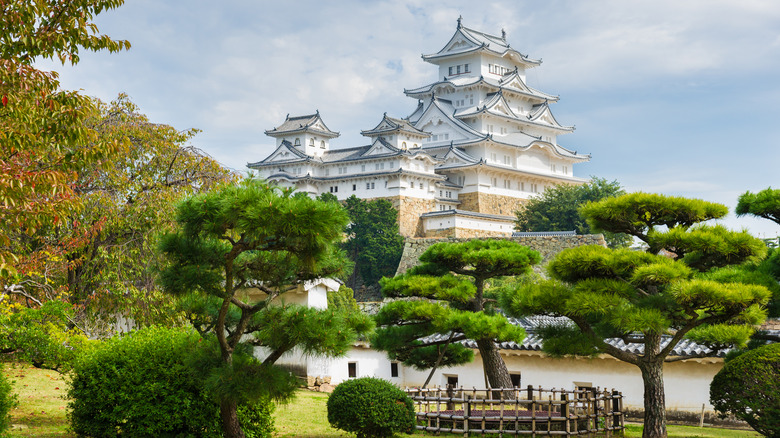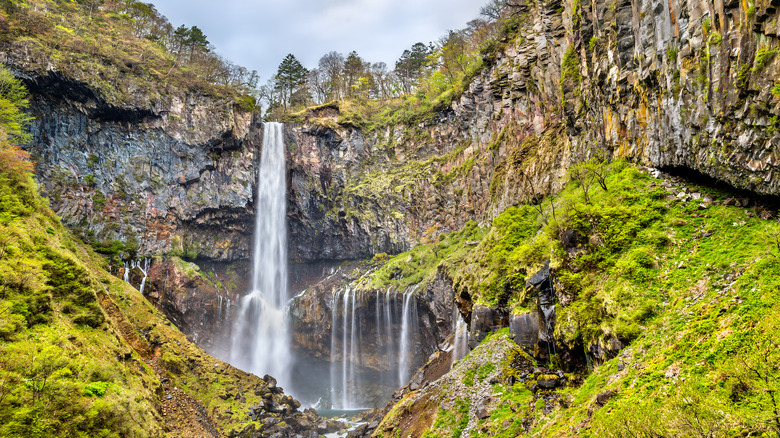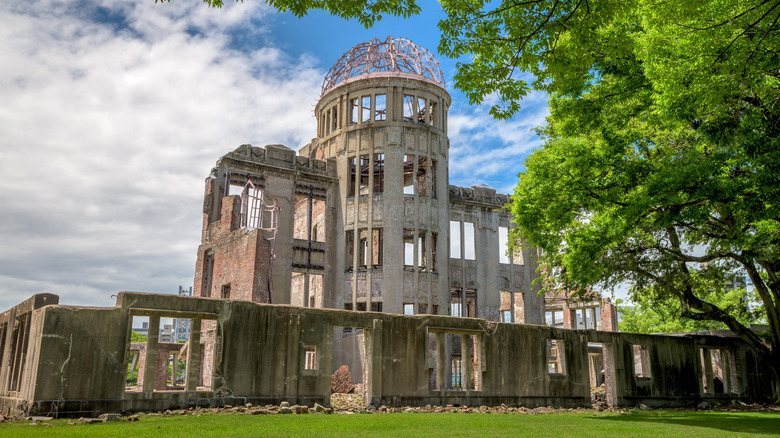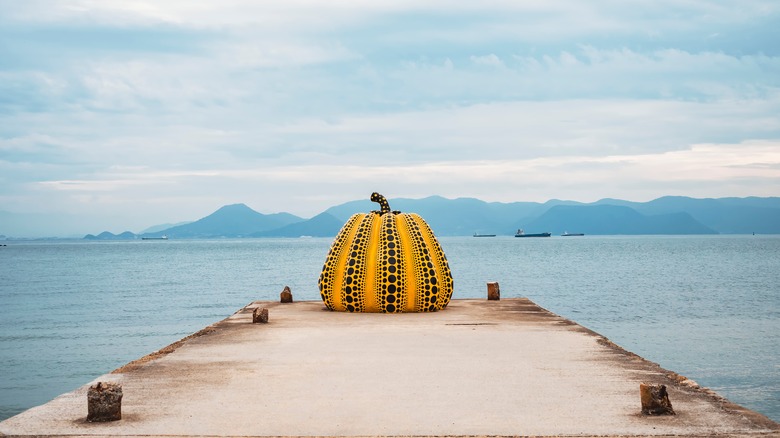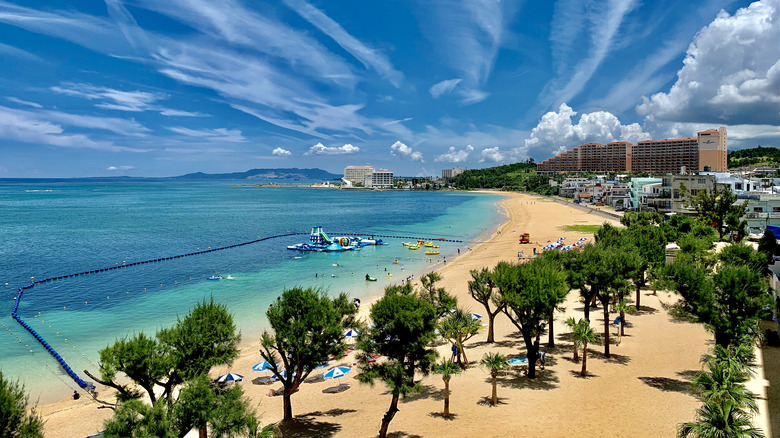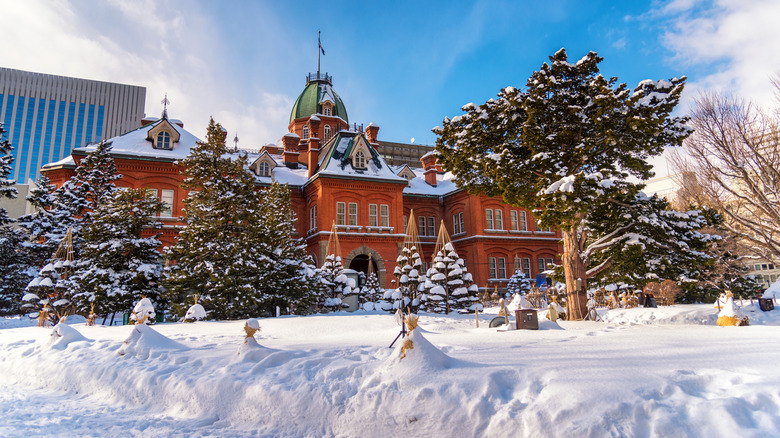Unmissable Tourist Destinations To Visit In Japan (That Aren't In Tokyo)
In March 2023, Japan was voted the most missed country in the world, meaning that travelers dreamed to return to the Land of the Rising Sun more than anywhere else following the COVID-19 pandemic. As for Tokyo, it was in the top five cities tourists missed the most. Now that travel restrictions have been lifted, millions are rushing to visit Japan and most travelers planning their dream trip are sure to include its bustling capital at the top of their itinerary. And rightly so. Between the incredible food, unique hotels, fantastic public transport, and plenty of budget-friendly options, Tokyo is a great destination for every type of traveler. However, Japan has much more to offer besides Tokyo, and heading off the beaten path comes with big payoffs.
Whether you're looking to become one with nature, immerse yourself in Japanese history, or tuck into mouth-watering cuisine – you name it – there's a destination with your name on it. Best of all, many of these world-class spots see smaller crowds than Tokyo and offer a more unique (and authentic) Japanese travel experience. Here are 12 unmissable tourist destinations to visit next time you're in Japan – that aren't Tokyo.
Step back in time in Kyoto
Japan's ancient capital is an essential part of any itinerary. The city became the country's political and imperial epicenter in 794 and held that honor until 1868 when Tokyo was chosen to take over. Today, visiting Kyoto is like journeying back in time. Walk the narrow lanes of the impeccably persevered Higashiyama District and you'll be surrounded by wooden townhouses and merchant shops that look just as they did centuries ago. Pay a visit to the historic geisha district of Gion and you may just spot a real-life geiko (geisha) or maiko (apprentice) – just remember to be respectful and keep your distance.
Other highlights include exploring the former Kyoto Imperial Palace, tucking into the freshest seafood at Nishiki Market, and strolling along Pontocho Alley in the evening to find a spot for dinner and drinks. Kyoto is also a religious epicenter and is home to a whopping 2,000 temples and shrines. Some of the most impressive include the UNESCO-listed Kinkaku-ji, also known as the Golden Pavilion, which is fully covered in gold leaf, as well as Kiyomizudera Temple, which was built among the lush vegetation halfway up Mt. Otowa. Then there's Fushimi Inari Shrine, famous for its 5,000-plus vermilion Torii gates and countless fox statues marking mountain trails.
Tip: A 20-minute train ride from Kyoto Station will get you to Arashiyama. Here you'll find the famous Bamboo Forest and Monkey Park Iwatayama, home to 120 wild Japanese macaques which you can actually feed.
Enter foodie heaven in Osaka
Osaka was heavily bombed during WWII, so it doesn't offer as many historical sites as nearby Kyoto, but it more than makes up for it in the culinary department. The city has become famous for its food scene and its nickname, "tenka no daidokoro," which translates to "the nation's kitchen."
Head straight for Dotonbori, comprising the Dotonbori Canal and Dotonbori Street, and hop between the endless array of restaurants, bars, and street food stalls as you admire the bright neon signs. Don't forget to take a photo with the Insta-famous Glico running man! Signature mouth-watering dishes include takoyaki (fried octopus balls), gyoza (crispy pan-fried dumplings), and a local specialty called okonomiyaki (a savory pancake). But it's not just street food that will get your mouth watering. Osaka is also home to some incredible restaurants, including a long list of options recognized by the Michelin Guide. These top-rated spots serve everything from world-class udon to sushi, yakitori, and beyond. For true opulence, check out the three Michelin star Kashiwaya or try La Cime, a French institution that has been recognized as one of the world's 50 best restaurants.
Once you've eaten your way through the city, make sure to stop by the fully rebuilt Osaka Castle, as well as Osaka Aquarium Kaiyukan, the largest aquarium in the world. There's also Universal Studios Japan, home to Super Nintendo World and the Wizarding World of Harry Potter.
Make friends with the famous deer of Nara
Want to be surrounded by adorable deer who'll bow to you in exchange for treats? No, it's not a fairytale we're describing — it's a real-life experience you can enjoy in Nara. The city was Japan's first capital until Kyoto was chosen to replace it in the 700s. Now, it's a UNESCO World Heritage Site and its crown jewel is inarguably Tōdai-ji Temple. Built in 752, it's home to the world's largest bronze statue of Buddha Vairocana, which clocks in at just over 49 feet. The nearby Isuien Garden, a breathtaking Japanese garden, is another must-see, as is Kofukuji Temple with its famed five-storied pagoda.
What really makes this city unique, though, is Nara Park, where 1,000 wild deer are allowed to roam freely. They're such an integral part of Nara that they've actually been designated a natural treasure. If you want them to be your BFFs, be sure to pick up some special crackers from one of the sales points in the park and you may find that some of the deer will actually bow to you to ask for one. And no trip would be complete without a stop at Nakatanidou, a mochi shop known for having some of the fastest mochi pounders in the country. Walk up to the open window and once there's enough of a crowd, the mochi masters will come out and make a show of working the mochi with huge wooden mallets in a blur of action that's unlike anything you've seen.
Enjoy Kobe beef in Kobe
When you hear the word "Kobe," you likely think of Kobe beef — rightly so. One of the most expensive and exclusive cuts of meat in the world actually comes from the city that shares its name. Not surprisingly, there are plenty of spots around Kobe where you can try the famous delicacy, which boasts a unique melt-in-your-mouth taste. Just two top-rated choices include Mouriya, which was founded in the 1880s, and the more modern Steak Aoyama, which opened its doors in 1963.
However, Kobe has a lot more to offer than just prime beef. One of the more surprising finds is Kitano Ijinkan-Gai, an area filled with 19th-century European-style homes that used to belong to foreign merchants and diplomats. Many have been beautifully preserved and now operate as museums, including the former residence of the Consul-General of the United States, as well as the French House, English House, and Italian House. Another highlight is the Nada Sake District where you can visit various breweries and museums to learn about (and sample) sake from one of Japan's top sake-producing regions.
Interestingly, Kobe is both a port city and a mountainous one. That means you can take in great harbor views from the Kobe Port Tower observation deck, then ride the Kobe Nunobiki Ropeway up Mt. Rokko for spectacular views of Kyoto and Osaka.
Immerse yourself in geisha and samurai culture in Kanazawa
The beautiful and impeccably preserved town of Kanazawa isn't as widely known as some of its historic counterparts, like Kyoto, and that's a good thing! The city is packed to the brim with neighborhoods that seem frozen in time and you can enjoy them all without huge crowds. Because Kanazawa wasn't bombed during WWII, wandering the city is like walking through living history and that's especially true of the geisha and samurai quarters.
First up, there's the must-visit Higashi-Chaya. This is the largest of Kanazawa's three historic entertainment districts (the other two are Kazue-machi and Nishi-Chaya) and is where you'll find Ochaya Shima, a 200-year-old teahouse turned museum that'll teach you all about the life of a geisha. And while visiting an "ochaya" or tea house usually requires you to be introduced by someone who's a member, Kaikaro offers the unique opportunity to have a tea break during the day in a historic ochaya where geisha still work. Also in the area, you'll find the Yasue Gold Leaf Museum, as Kanazawa is responsible for 99% of Japan's gold leaf production.
Take a lunch break and enjoy incredible seafood at Omicho Market, then head to Nagamachi, the city's samurai district. Here, you can see how samurai of various ranks lived thanks to a number of homes that have been turned into small museums. Other highlights include the 16th-century Kanazawa Castle, the ever-peaceful Kenrokuen Garden, and the world-class 21st Century Museum of Contemporary Art.
Discover Japan's Little Venice in Kurashiki
Japan is full of surprises and Kurashiki is one of the biggest. Often referred to as Little Venice or the Venice of Japan, the city does indeed boast canals that make it feel like its Italian counterpart. A boat ride on a punt is therefore a must, as is a visit to the Bikan Historical Quarter. Here you'll find 400-year-old homes, which have been turned into restaurants, galleries, and shops. Some of the residences have also been preserved as small but interesting museums. Two highlights include Ohashi House, which once belonged to a merchant who made his fortune off rice fields, and Inoue House, which belonged to a town administrator and is the oldest surviving townhouse in the city. Kurashiki Ivy Square, the former home of the Kurashiki Spinning Works cotton mill, is also worth a stop and has an array of restaurants, shops, and even a hotel.
Apart from the canals, another surprise is the Ohara Museum of Art, whose impressive art collection includes unexpected Western masterpieces by the likes of El Greco, Paul Gauguin, Claude Monet, and Henri Matisse. Yet another unexpected highlight is Denim Street. Kurashiki is actually the birthplace of Japanese denim and to this day, its denim is sought after by luxury brands like Chanel and Louis Vuitton. Here you'll be able to buy top-quality products from various local brands and even try a denim soft serve ice cream.
Explore one of Japan's most important castles in Himeji
Among Japan's many UNESCO World Heritage Sites are a number of unique and impressive castles. Usually surrounded by moats and stone walls, these instantly recognizable structures were designed to protect their inhabitants: The ruling feudal lords and their families. Today, you'll find beautiful examples in Osaka, Kanazawa, and a handful of other cities, but one of the most breathtaking is in Himeji. Nicknamed White Heron Castle, Himeji Castle is actually considered by many to be the very best example of a Japanese castle in the country. The complex is made up of 83 buildings whose construction began in 1333 and what makes it truly unique is that it was untouched during WWII. Himeji Castle is so important, in fact, that it was the first-ever site in Japan to be recognized by UNESCO (alongside the Hōryūji Temple Area in Nara).
Once you're done visiting this impressive compound, head for a tranquil stroll at the nearby Koko-en Garden, which is really nine gardens. Each one showcases a different style popular in the Edo Period (1603-1868), including a tea garden, flower garden, and bamboo garden. Last but not least, you'll want to check out Shoshazan Engyoji Temple atop Mt. Shosha. Tom Cruise fans will instantly recognize it as the backdrop for much of "The Last Samurai" and it can be easily reached in just half an hour by bus and a ride on the Mt. Shosha Ropeway.
Become one with nature in Nikko
If you're looking to get a little closer to nature during your time in Japan, then Nikko is the destination for you. It's the entryway to Nikko National Park whose most popular area, Okunikko, offers opportunities to hike in the warm months and ski and snowshoe in the winter. Highlights include Mt. Nantai (actually a volcano) and its two-and-a-half-mile mountain trail, which is recommended for experienced hikers. There's also Lake Chuzenji at its base, which is Japan's highest natural lake and has a stunning 15-and-half-mile hiking trail wrapped around its perimeter.
Closer to town you'll find the Kanmangafuchi Abyss where you can hike through a gorge along a pretty riverside path, as well as the 246-foot Kirifuri Waterfall, which runs between lush trees and is especially impressive in the autumn. Hidden in Nikko's beautiful forests you'll also find Japan's most lavishly decorated shrine. Built in the 1600s as a mausoleum for shogun Tokugawa Ieyasu, Toshogu Shrine is decorated with an overflow of gold leaf. The nearby Taiyuin mausoleum, built for his grandson, is equally impressive, as is the 8th-century Rinnoji temple.
Nikko is also known for all the hot springs or "onsen" found in the area. The nearby Kinugawa-Kawaji Onsen is one of Japan's most famous hot spring resorts and boasts 80 hotels and ryokans to choose from. It's the perfect place to unwind and experience a truly Japanese pastime.
Pay a sobering visit to Hiroshima
Unlike the other cities on this list, Hiroshima offers a chance for introspection and a sobering look at what can happen when the world doesn't strive for peace. Its painful history is centered around a single day –- August 6, 1945 –- when it became the first city in the world to be hit by an atomic bomb. The very site where that bomb was dropped has now been transformed into Peace Memorial Park, which is where you'll find the Hiroshima Peace Memorial Museum. It's a difficult but important stop and visitors are sure to be moved by the museum's permanent collection, which includes photos, personal objects left behind by victims, and video testimonials from survivors. Also in the park is the Hiroshima Peace Memorial or A-Bomb Dome, one of the few buildings that was left standing amid the destruction. Its charred, eerie remains are not something you'll soon forget.
Despite its dark past, Hiroshima also offers visitors some lighter attractions, like the 16th-century Hiroshima Castle, which was fully rebuilt after the war and houses an interesting exhibit of samurai weapons and armor that once belonged to the castle's lords. Car lovers should also make time to visit the Mazda Museum. Visits must be reserved online in advance and give folks the chance to see the museum, as well as tour an actual production plant.
Take a ferry to an art lover's paradise on Naoshima Island
Naoshima Island made international news in 2021 when a typhoon swept its most recognizable work of art -– a giant yellow pumpkin by the most Instagrammed artist on earth, Yayoi Kusama –- into the sea. The viral moment shocked art lovers, but as of 2022, a new yellow pumpkin is back in its place and can once again be enjoyed by visitors. However, Naoshima Island has much more to offer art lovers. The island is packed with modern art museums, galleries, and installations, and even has several beautiful hotels where you can spend the night.
Many of the buildings were designed by famed Japanese architect Tadao Ando, including the Benesse House Museum, which is both museum and hotel, as well as the Chichu Art Museum whose collection includes works by Claude Monet and James Turrell. One of the most unique works on the island is an installation called Naoshima Bath where you can actually soak in its hot waters. Equally special is the Art House Project in which artists have taken over seven empty homes and counting, turning them into artworks.
Tip: Naoshima Island is accessible by a 20-minute ferry ride from Uno Station, which is 40 minutes from Okayama Station. When you arrive at the Naoshima pier, you'll be greeted by another of Yayoi Kusama's famous pumpkins (this one is red!) and you can either explore on foot, rent a bike, or make use of the free shuttle bus.
Take a road trip around Okinawa Main Island
When most people think of Japan, they think of Honshu, the largest and most populated island, which is home to Tokyo. However, the Japanese archipelago is actually made up of 6,852 islands, so naturally, we had to include a few on this list. At the southernmost tip, you'll find Okinawa Prefecture, made up of 160 islands, the biggest being Okinawa Main Island. Unlike the rest of Japan, the region is known for its subtropical climate, white sand beaches, and crystal clear waters — perfect for swimming, snorkeling, and scuba diving. In order to really get a feel for the island, it's best to spend at least five days and rent a car (you'll just need an international driver's license).
The perfect starting point for your road trip is the capital city of Naha. This is where the airport is and it's home to numerous must-sees, like the UNESCO-listed Shurijo Castle and Naminoue Shrine, set on a cliff above the only swimming beach, Naminoue Beach. You can then make your way to the central part of the island to discover Koza (a hub for live music and nightlife), Yomitan Village (home to traditional arts and crafts and beautiful beaches), and the cosmopolitan Chatan, which many tourists choose as their base for exploring. Further north, you'll find nature activities galore, from hiking in subtropical forests to canoeing through mangroves. There are also plenty of beaches and if you want a bit of luxury, you can check out the Onna Coast, Okinawa's top beach resort destination.
Embrace winter in Sapporo
While Okinawa has plenty to offer those seeking fun in the sun, Sapporo, located on Japan's northernmost island of Hokkaido, is the perfect destination for lovers of winter sports. And while there's plenty to do in the warmer months, including hiking trails for all skill levels, the city really shines as temperatures drop. After all, it did host the 1972 Winter Olympics. Settle into one of the top-notch ski resorts and hit the slopes or simply explore all that the city has to offer. One particular standout is the yearly Sapporo Snow Festival, which is held every February. It brings together talented snow and ice sculptors from around the world to create giant works of art, which become absolutely magical as they're illuminated each night.
If you'd like to get indoors to warm up, you can stop by the Sapporo Olympic Museum for some local history or learn all about the city's famous export at the Sapporo Beer Museum. Sapporo is also known for its exceptional seafood and it doesn't get fresher than at Nijo Fish Market. Additionally, you can head up to the observation deck on the Sapporo TV Tower (modeled after the Eiffel Tower) for incredible city views, or get a crash course in Japanese history at the Historical Village of Hokkaido. Located in the city's suburbs, this unique open-air museum showcases 52 restored buildings dating back to the 1860s which showcase what life was like in a fishing village, farm village, mountain village, and central town.
